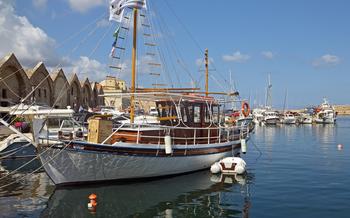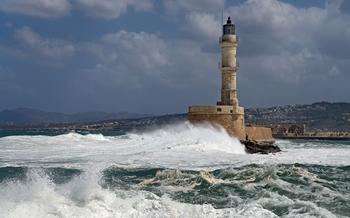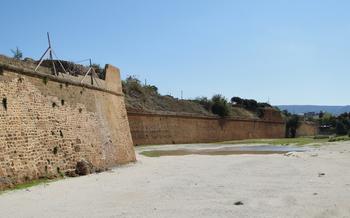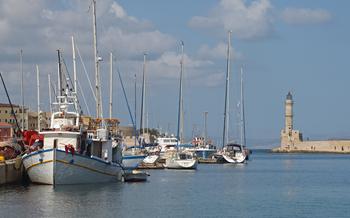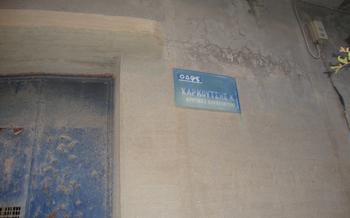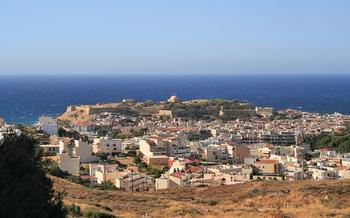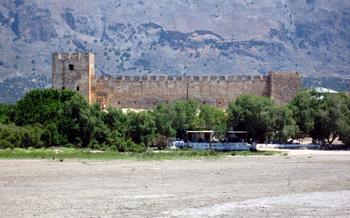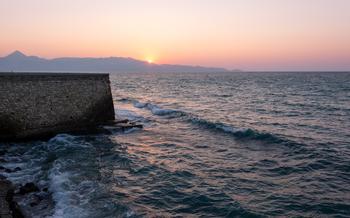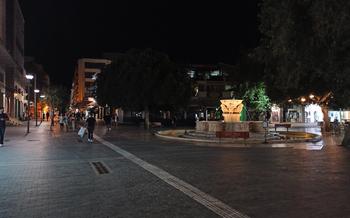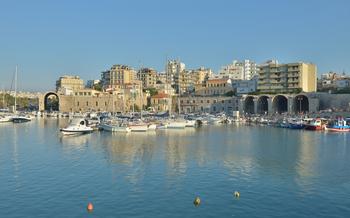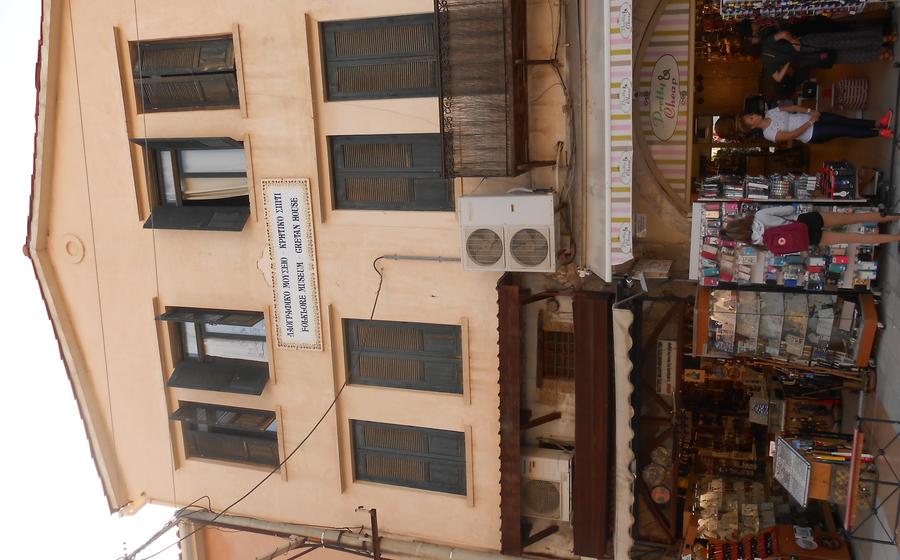
Folklore Museum of Chania
- Historical Background
- Museum Location
- Hours of Operation and Admission Fees
- Exhibits and Collections
- Traditional Craftsmanship
- Architecture and Building Techniques
- Agriculture and Farming
- Maritime Heritage
- Music and Dance
- Religious Traditions
- Educational Programs and Workshops
- Interactive Displays
- Souvenir Shop
- Insider Tip
Historical Background
Chania, a captivating city nestled on the northwestern coast of Crete, boasts a rich and storied past that dates back to the Minoan era. Over the centuries, Chania has witnessed the rise and fall of various civilizations, each leaving an indelible mark on its cultural tapestry. The city's strategic location as a major port has made it a melting pot of diverse cultures, from the Venetians and Ottomans to the modern Greeks.
The Folklore Museum of Chania stands as a testament to this rich history, preserving and showcasing the traditional way of life, customs, and crafts of the region. Established in 1963, the museum is housed in a beautifully restored Venetian building in the heart of the Old Town, offering visitors a glimpse into the soul of Crete and its people.
Museum Location
The Folklore Museum of Chania is conveniently located in the heart of the city, within easy walking distance of many other historical landmarks and attractions. It is situated at 6, Chalidon Street, close to the Old Venetian Harbor, one of the most iconic sights in Chania. To get there, you can take a leisurely stroll through the charming streets of the old town, admiring the Venetian and Turkish architecture along the way. Alternatively, if you prefer a more direct route, you can take a taxi or catch a local bus that stops nearby.
Once you arrive at the museum, you'll find it housed in a beautifully restored 17th-century Venetian building, adding to its historical charm. The building itself is a testament to the rich heritage of Chania and provides a glimpse into the city's past.
Hours of Operation and Admission Fees
The Folklore Museum of Chania stands ready to welcome visitors from all corners of the globe, boasting an accommodating schedule that remains constant throughout the year. Step through its doors during the summer months, from April to October, and immerse yourself in its treasures between the hours of 9:00 am and 7:00 pm. As the seasons shift, the museum adjusts its hours accordingly, opening from 8:30 am to 3:30 pm during the winter months, from November to March.
Admission fees are modest, ensuring that all who seek knowledge and cultural enrichment can partake in this journey through time. Adults seeking enlightenment will contribute a mere €3, while students eager to expand their horizons can enter for a reduced fee of €Groups exceeding the threshold of 20 individuals are eligible for a further discount, paying only €50 per person. Entrance is granted free of charge to children under the age of six, allowing families to embark on this educational adventure without financial constraints.
Exhibits and Collections
The Folklore Museum of Chania boasts a diverse and captivating collection of artifacts that provide a glimpse into the rich cultural heritage of the region. Among the highlights are traditional costumes, intricately woven textiles, and exquisite embroidery that showcase the exceptional craftsmanship of Chania's artisans. Visitors can admire the vibrant colors and intricate designs of these garments, which were often worn during festivals and special occasions.
The museum also houses a collection of pottery and ceramics that demonstrate the skill and artistry of local potters. From simple, utilitarian pieces to elaborately decorated vases and plates, these objects offer a glimpse into the daily lives and customs of Chania's inhabitants.
Additionally, the museum features a collection of agricultural tools and implements that shed light on the region's agricultural heritage. These tools, such as ploughs, sickles, and threshing machines, provide insight into the traditional farming practices and techniques that have sustained the local communities for centuries.
Another highlight of the museum's collection is the display of traditional musical instruments, such as the lyra, the lute, and the bouzouki. These instruments, often accompanied by traditional dance performances, play a vital role in the vibrant music and dance traditions of Chania.
Traditional Craftsmanship
The Folklore Museum of Chania is a treasure trove of traditional craftsmanship, showcasing the skills and techniques passed down through generations in the region. Among the highlights of the collection are exquisite pottery pieces, each intricately hand-painted with vibrant colors and intricate designs. These ceramics, often used for everyday purposes such as storing food or water, are a testament to the artistry and functionality of traditional pottery techniques.
Another highlight of the museum's craftsmanship collection is the intricate woven textiles. From delicate lace doilies to colorful carpets and rugs, the weavings showcase the skill and patience of local artisans. Each piece is a unique work of art, displaying a variety of patterns and textures that reflect the region's rich textile traditions.
Embroidery is another traditional craft that holds a special place in the museum's collection. From intricate floral motifs to geometric designs, the embroidered pieces on display showcase the artistry and precision of local needleworkers. These textiles, often used to decorate clothing or household items, add a touch of elegance and charm to everyday objects.
The museum also features a variety of other traditional crafts, such as woodcarving, metalworking, and leatherworking. These crafts, often passed down from father to son or mother to daughter, represent the diverse skills and talents of the local artisans. Whether it's a finely carved wooden chest, an intricately patterned metalwork piece, or a beautifully crafted leather bag, each item on display tells a story of tradition, skill, and creativity.
Architecture and Building Techniques
Chania's architectural heritage is a testament to the city's rich history and cultural influences. The Folklore Museum of Chania showcases the unique architectural styles and building techniques that have shaped the city's landscape over the centuries.
Exhibits on traditional houses highlight the distinctive features of Cretan architecture, such as the use of stone, arched doorways, and internal courtyards. Visitors can learn about the construction techniques and materials used in these traditional dwellings, which were designed to withstand the region's harsh climate and provide comfort and privacy.
The museum also features examples of religious architecture, including churches and monasteries. These buildings often display intricate frescoes, iconography, and decorative elements that reflect the deep religious traditions of the region. Fortifications and public buildings, such as the Venetian Arsenals, are also represented in the museum, showcasing the city's rich history and strategic importance.
Through these exhibits, visitors gain insights into the architectural heritage of Chania and the factors that have shaped the city's unique identity.
Agriculture and Farming
Agriculture has played a crucial role in the history and economy of Chania. The museum's exhibits on agriculture shed light on the traditional farming practices and techniques that have shaped the region's agricultural heritage. Visitors can explore displays of traditional farming tools, such as plows, sickles, and threshing machines, which provide insights into the hard work and dedication of local farmers.
Exhibits on various crops, such as olives, grapes, and citrus fruits, showcase the significance of agriculture in Chania's economy. Visitors can learn about the traditional methods of cultivation, harvesting, and processing these crops, which have been passed down through generations. Interactive displays allow visitors to experience the challenges and rewards of farming in this region, highlighting the importance of agriculture in shaping the cultural identity of Chania.
Maritime Heritage
Chania's Enduring Bond with the Sea
Chania's maritime heritage is deeply woven into the fabric of its history and culture. The city's strategic location on the Cretan Sea made it a thriving port and a hub for trade and commerce throughout the centuries. The Folklore Museum of Chania pays homage to this maritime legacy with a captivating collection of exhibits that showcase the city's shipbuilding prowess, navigation skills, and fishing traditions.
Among the highlights of the maritime collection are meticulously crafted models of traditional wooden sailing ships, each representing a different era in Chania's maritime history. Visitors can admire the intricate details of these models, from the finely carved hulls to the billowing sails, which provide a glimpse into the craftsmanship and ingenuity of Chania's shipbuilders.
Another fascinating exhibit explores the navigational instruments and techniques used by Chania's seafaring merchants and explorers. From ancient astrolabes to intricate compasses, these tools allowed sailors to navigate the vast Mediterranean Sea with remarkable accuracy, enabling them to chart new routes and discover distant lands.
The museum also sheds light on the traditional fishing practices that have sustained Chania's coastal communities for generations. Visitors can learn about the different types of fishing nets, hooks, and traps used by local fishermen and gain insights into the challenges and rewards of life at sea. Interactive displays allow visitors to experience the thrill of hauling in a net filled with glistening fish, providing a taste of the challenges and rewards of this ancient profession.
Through its maritime collection, the Folklore Museum of Chania invites visitors to embark on a journey through the city's rich seafaring history, celebrating the ingenuity, resilience, and adventurous spirit of its people.
Music and Dance
Chania's vibrant music and dance traditions hold a special place in the Folklore Museum. Immerse yourself in the sounds of traditional instruments like the lyre, lute, and violin, which fill the air with enchanting melodies. The museum showcases a remarkable collection of these instruments, providing insights into their craftsmanship and the artistry of local musicians.
Among the highlights of the music exhibit is a rare collection of vintage recordings featuring renowned Cretan musicians. Listen to the soulful tunes and captivating rhythms that have captivated generations, transporting you to a time when music and dance were integral to everyday life in Chania.
The museum also features displays on traditional Cretan dances, showcasing the intricate steps, colorful costumes, and lively performances that define this vibrant cultural expression. Discover the stories behind these dances, such as the famous "Pentozali," a spirited dance originating from the countryside, or the graceful "Sousta," a symbol of Cretan pride and resilience.
Whether you're a music enthusiast or simply curious about the rich cultural heritage of Chania, the Folklore Museum offers a captivating journey into the heart of Cretan music and dance.
Religious Traditions
Chania, like many parts of Greece, is a place of diverse religious traditions and beliefs. The Folklore Museum of Chania offers a glimpse into the religious practices and rituals that have shaped the cultural heritage of the region. Exhibits showcase a collection of icons, religious artifacts, and traditional costumes worn during local religious festivals. Visitors can learn about the unique customs and ceremonies associated with major holidays and celebrations, such as Easter and Christmas, which hold a special place in the hearts of the local communities. The museum also provides insights into the role of religion in everyday life, highlighting the significance of religious symbols and rituals in shaping the social and cultural fabric of Chania.
Educational Programs and Workshops
The Folklore Museum of Chania offers a range of educational programs and workshops that provide visitors with a deeper understanding of traditional crafts and customs. These programs are designed to engage visitors of all ages, from children to adults, and are a great way to immerse yourself in the rich cultural heritage of Chania.
One of the most popular programs is the traditional crafts workshop, where visitors can learn the basics of pottery, weaving, and embroidery. Under the guidance of experienced artisans, participants can create their own unique souvenirs to take home. The museum also offers cooking classes, where visitors can learn to prepare traditional Cretan dishes using fresh, local ingredients.
For those interested in learning more about the history and culture of Chania, the museum offers guided tours and lectures. These tours provide an in-depth look at the museum's collection and the stories behind the artifacts. The museum also hosts regular events and workshops throughout the year, such as traditional music and dance performances, storytelling sessions, and craft demonstrations.
These educational programs and workshops are a fantastic way to engage with the local culture and gain a deeper appreciation for the traditions and customs of Chania. Be sure to check the museum's website or ask at the information desk for more information on upcoming programs and events.
Interactive Displays
The Folklore Museum of Chania is not just a collection of artifacts; it is an interactive journey into the past. Visitors can engage with the exhibits through multimedia presentations, interactive displays, and hands-on activities. These interactive elements bring the museum's collection to life, allowing visitors to experience the sights, sounds, and traditions of Chania's rich history firsthand.
One of the highlights of the museum's interactive displays is a virtual tour of a traditional Cretan village. Visitors can explore the village's streets, peek into the homes of its inhabitants, and learn about their daily lives. Another interactive exhibit allows visitors to try their hand at traditional crafts, such as pottery and weaving. This hands-on experience gives visitors a deeper appreciation for the skill and craftsmanship that went into creating the museum's collection.
The Folklore Museum of Chania's interactive displays are a great way for visitors of all ages to learn about the region's history and culture. These engaging exhibits make the museum a truly immersive and memorable experience.
Souvenir Shop
At the end of your enlightening journey through Chania's history and culture, don't miss the opportunity to visit the museum's gift shop. This treasure trove offers a delightful array of souvenirs that will serve as lasting mementos of your visit to this captivating city.
From intricately hand-painted ceramics and woven textiles to replicas of ancient artifacts and traditional jewelry, the gift shop is a treasure trove of unique and authentic items. You'll find an array of gifts to suit every taste and budget, whether you're looking for a small token of remembrance or a special gift for a loved one.
Consider purchasing a piece of traditional Cretan pottery, a colorful woven rug, or a beautifully crafted piece of jewelry inspired by ancient Greek designs. These items not only make for lovely souvenirs but also support local artisans who keep alive the rich traditions of Chania's craftsmanship.
For those who want to delve deeper into the region's history and culture, the gift shop also offers a selection of books, postcards, and DVDs. These educational materials provide a wealth of information on Chania's past, its people, and its customs, allowing you to continue your exploration long after your visit to the museum.
Insider Tip
For an immersive experience, plan your visit to coincide with one of the museum's cultural events or demonstrations. These events often showcase traditional crafts, music, or dance performances, providing a deeper insight into the living heritage of Chania. Check the museum's website or social media pages for upcoming events and schedules. Additionally, consider joining a guided tour to gain valuable insights from knowledgeable docents who can share captivating stories and anecdotes about the exhibits and the history of Chania. Guided tours are typically offered in multiple languages and can be booked in advance or arranged upon arrival.
